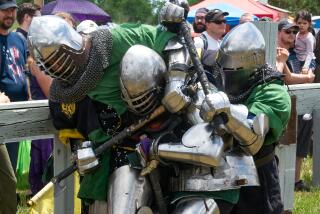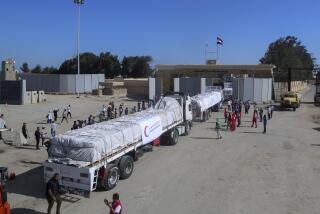Life, death and politics in Peru
There’s a country in the Western Hemisphere where people still suffer post-traumatic stress from violent events that happened years ago, politics fester with corruption, public opinion is bitterly polarized and the media are widely distrusted, if not despised.
Besides the United States, that is.
With a population (28 million) about the same as Iraq’s, spread over an area three times the size of California, Peru probably has experienced more tragedy per capita or square-mile than all but a handful of regional hotspots. And though the world’s attention lately has been focused on places like Baghdad and Darfur, few other countries over the last five years can match Peru’s long string of bizarre social upheavals and vicious assaults on the body politic.
In that brief span, this nation has seen its autocratic president Alberto Fujimori driven into exile, and his notorious spy chief Vladimiro Montesinos led away in handcuffs on charges of orchestrating kidnappings, mass torture and death squad carnage. It has watched as dozens of public officials, plutocrats and journalists were arrested for taking bribes, and worse. It has witnessed bloody street protests in Lima and public lynchings in picturesque Andean villages, and it has shuddered at signs that the brutal and terrifying Maoist guerrilla group Sendero Luminoso (Shining Path) may be on the march again.
Trying to condense these developments into coherent prose and compelling pictures has been the task of El Comercio, arguably the country’s most respected daily newspaper. While Peru is awash in tabloid sensationalism and TV and radio rumor-mongering, El Comercio offers its readers a more sober take on the country’s relentless travails.
This month, El Comercio has taken an unusual, extra step in its efforts to help Peruvians make informed decisions. As the country braces for an April 9 presidential election, El Comercio is sponsoring a photo-journalistic recap of recent Peruvian history. Staged at an art gallery in the capital’s center, the aim of its exhibition is to reconstruct the ugly and uplifting chapters of the national narrative, and to provide context to the upcoming election.
Titled “Mirate” (“Look at Yourself”), the show comprises some 60 photos taken by El Comercio staffers between Jan. 1, 2000 and the beginning of this year. Nancy Chappell, an El Comercio photographer who helped curate the exhibition with independent photographer-curator Mayu Mohanna, says that “Mirate” has drawn thousands of visitors, first at a previous location, in the haute monde Miraflores seaside district, then at its current home, the Juan Pardo Heeren gallery in the capital’s gritty center.
The exhibition, the first of its kind mounted by the newspaper, is part of a broader, months-long initiative by El Comercio to create public forums for addressing such national issues as health, education and the economy, as Peruvians head to the polls. The exhibition is scheduled to close this weekend.
“For us it was a success in the sense that, well, the people hear more the name El Comercio, but above all it was that, in truth, people took interest in the subject,” Chappell says, ushering a visitor through the gallery one day last week. “For us, really, it was a great surprise that the people took such interest in a political theme.”
Humor and darkness
Arranged chronologically, the photos trace the country’s roller-coaster-from-hell trajectory, from the street fighting that ended with Fujimori’s downfall, to the establishment of a transition government, to the setbacks and disillusionments that have accompanied Peru’s struggle back toward putative democracy. Wall texts, written in a just-the-facts style, help put the images in perspective.
Years after they were made, the most graphic and disturbing images haven’t lost their power to shock. Several photographs document the so-called March of los Cuatro Suyos, in late July 2000, an urban brawl -- sparked by Fujimori’s constitutionally questionable attempt to run for the presidency a third time -- that left seven dead and 80 wounded.
In one picture, current president Alejandro Toledo, a Fujimori foe, is shown hastily putting on a gas mask.
The suffering in this period was equally great in the remote Indian villages of the Andes, a world apart from Lima. A beautifully composed shot by Manuel Garcia Miro depicts a mass funeral-burial of Shining Path victims unearthed in 2003, the solemn procession of silver coffins winding through emerald green hills.
Not all is gloom. In some photos, seriousness brushes up against pathos, irony or dark humor. A picture taken by Veronica Salem on Sept. 19, 2000 shows a smiling Fujimori outside the presidential palace, waving to a group of supporters, apparently oblivious to the fact that his hand has been blackened by grease used to keep protesters from climbing the palace gratings. Photographer Ines Menacho playfully catches a solicitous Toledo and the visiting George Bush arm in arm, each urging the other to go first, so that they appear to be waltzing together.
A large section of the exhibition is devoted to images of what Latin Americans call the vida cotidiana, daily life in all its revelatory normality and occasional surrealism: bathing-suited beauties posing before a giant photo of Machu Picchu, Indian women playing their annual take-no-prisoners soccer match, and a gorgeous black-and-white image of a traditional Ayacucho wedding.
Job hazards
On the two-story gallery walls, selected quotes give additional resonance to the images. One of them reads, in Spanish: “Probably George Bush thinks that it’s hard to be the president of the United States, but let me tell you that to be president of Peru could be even harder.” President Toledo said that during a 2003 speech at Stanford University.
There’s also a 20-minute video of the newspaper’s photographers discussing their work and the difficult circumstances in which many of their pictures were taken. In addition to the occupational risks in such hazardous times, Peruvian photographers must deal with the challenge of communicating with the large number of Andean Indians whose first language is one of the various dialects of the native Quechua tongue, says photographer Lino Chipana, 39, who has logged 19 years in the business. In one notorious incident in the early 1980s, Indian peasant farmers murdered a group of photographers and journalists whom they mistook for guerrillas (they apparently thought their cameras were weapons).
The gallery sits in a busy commercial thoroughfare, its doors open to the street. Cumbia tunes and the sound of honking cars drift in across the sidewalk, and because the gallery keeps late hours, visitors can easily wander in on their lunch hour or their way home from work.
Chappell says it’s been especially gratifying that teachers have been taking schoolchildren who are too young to have experienced firsthand the events depicted in “Mirate,” but still are curious about their nation’s history.
“They begin to read and remember and they develop a conscience,” she says. “And they are also our voters of the future, no?”
What that future will look like, even in the short term, is anybody’s guess. Fujimori, who flew from Japan to South America last fall in what was widely seen as the start of a comeback attempt, is currently being held in Chile while awaiting possible extradition to face human rights and corruption charges here. (The former president has denied the allegations.)
Meanwhile, the presidential election is being contested by a record-setting 25 candidates, producing a circus-like media atmosphere. The exhibition hints at the present uncertainty with its final image, Miguel Bellido’s shot of an empty chair, draped with a red and white sash.
Jose Francisco Lara, 60, who works for a seafood export company, was among the gallery visitors one recent evening. He says it was good that the project was being sponsored by El Comercio, “which nearly always has shown a line of credibility.”
“I suffered through all the things that happened throughout this time,” he says, indicating the photos. Reliving the memories is painful, but he was glad that he had come. “We can’t forget what happened.”
More to Read
Start your day right
Sign up for Essential California for news, features and recommendations from the L.A. Times and beyond in your inbox six days a week.
You may occasionally receive promotional content from the Los Angeles Times.







